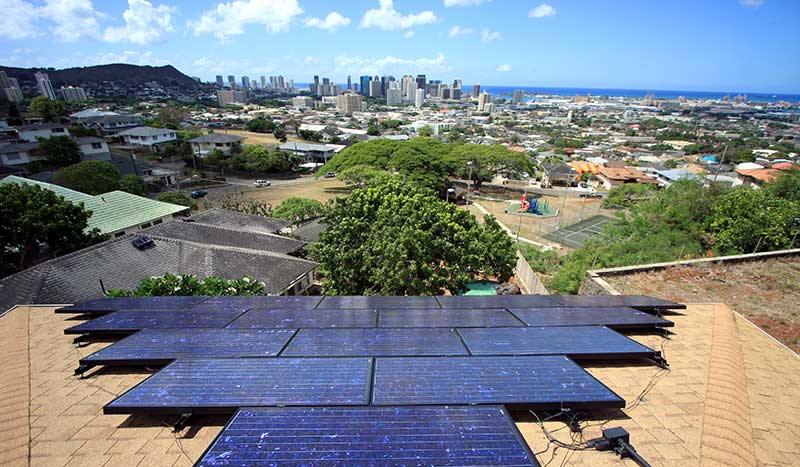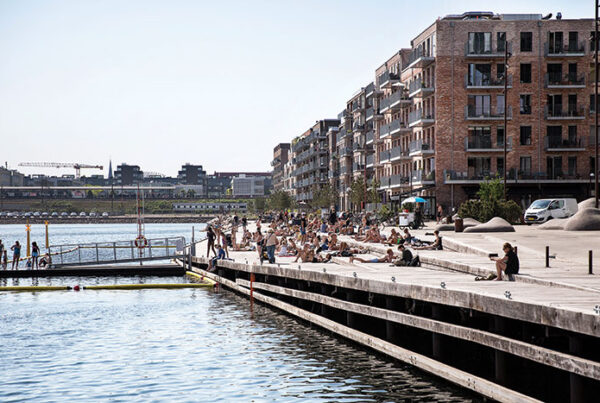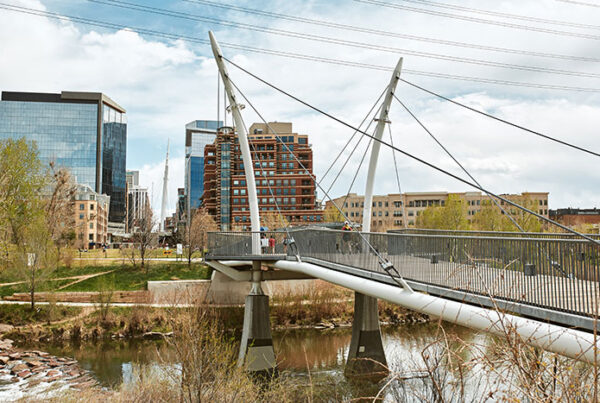How is COVID-19 affecting the triple bottom line?
![]()
Members of ULI’s Responsible Property Investment Council discuss the impact of the COVID-19 pandemic on real estate investment, strategies for navigating through economic uncertainty, the rising profile of sustainability measures, and other trends.
What impact has COVID-19 had on investing in the triple bottom line—people, the planet, and profit?
Molly McCabe: COVID-19 has pushed health and wellness to the surface. The industry is talking much more consistently about indoor air quality and access to nature in buildings. Hotels are pursuing wellness certification to let guests know that the rooms are healthy and have better air quality. And guests are willing to pay a premium for those rooms, whereas a few years ago, that was considered a novelty. There is an opportunity to position our assets to showcase that they are best in class, taking the environment and sustainability and resilience into consideration. I think COVID has brought that to the forefront.
Jack Davis: We’ve seen no slowdown in interest in environmental, social, and governance [ESG] programs from clients or prospective clients; if anything, interest has accelerated. And when I reached out to our clients who were working on ESG programs to help them figure out the implications of COVID-19, I found that for a lot of them, the ESG team had become the de facto COVID team, figuring out how to run the real estate during a new era of social distancing.
Amy Erixon: There is an unprecedented amount of money in the investment markets, and yet there has been less activity in real estate transactions. Investors are taking a wait-and-see attitude toward future space demand, but they are also using this time as an opportunity to reflect on their investment programs and how they align with their values. COVID has accelerated trends that already existed, especially in the areas of creating healthy buildings, ecologically friendly environments, and more access to open space. Also, after the death of George Floyd, pension funds with diversity and inclusion goals have redoubled their efforts to meet those goals. Two examples of the public sector rethinking the social role of real estate: some provinces here in Canada have approached the real estate community about donating spaces in locations and facilities that have already been managed for COVID protocols, such as malls, to provide space for vaccinations during the winter. A second example is approaching hoteliers about providing temporary shelter for the homeless, quarantined travelers, and frontline medical workers concerned about their families’ safety.
Bettina Mehnert: Especially now, with the virus highlighting that, companies can’t focus only on profit, they have to look at the triple bottom line. COVID has had a catastrophic impact on Hawaii because we are so dependent on tourism, affecting not only the hospitality sector but every sector that supports it. The Sustainability Business Forum, a group of business executives in Hawaii who have made a commitment to the triple bottom line, has been discussing how we can help develop a more diverse infrastructure, which includes investing in education. Our universities as well as our community colleges have put together a curriculum that’s helping displaced workers learn new skills, especially in the energy and agriculture industries.
How are investors working to navigate the economic uncertainty ahead?
Davis: A lot of companies are still insulated because they are under leases that haven’t expired, and they have already implemented strategies and negotiated with landlords on rent deferments. We’re not that far off from the 2008 economic crisis, so there is a lot of muscle memory that people are acting on in resolving the short-term impact from a declining economy. Starting this year, however, when some of those temporary Band-Aids start expiring and leases come up for renewal, then we may see significant changes. Fortune 500 tenants in the bigger class A office buildings are going to be able to pay their rent, and the landlords for those buildings will be fine. In the retail and hospitality sector, however, it’s a different story.
Erixon: The retail sector has been badly impacted, so retail owners are trying to figure out creative alternative uses and redevelopment scenarios, like adapting strip centers into affordable housing and building condominium or apartment towers on empty big-box store sites. There is discussion for the first time in many places of passing inclusionary zoning laws that would require new residential developments to include affordable housing units. Apartment rents have dropped in some places, which helps a bit with affordability, but demand is only going to increase, so we need new strategies to address affordability, particularly in cities that are already large or are growing rapidly.
Mehnert: Hawaii has little land left for development. We have to balance agriculture, tourism, conservation, and a tremendous need for affordable housing, so interest in adaptive use is picking up. Even before the pandemic, there was the challenge of what happens with shopping centers, and now also office buildings. So what are we going to do with all this surplus office space? There is an opportunity to look at converting it to affordable housing. And it seems logical that many shopping centers could be adapted into senior housing, because they have walkable spaces.
McCabe: People in the real estate industry are becoming more aware that they need to think about different risk factors than they did before. Last year, Spencer Glendon [senior fellow at the Woodwell Climate Research Center in Falmouth, Massachusetts] spoke to ULI’s trustees about sample bias in relation to why we’re unprepared for where the world is going. It all depends on the data set you choose: if you look at the past 75 years, there have been no world wars, we’ve had one bout of inflation and one economic crisis, and 37 of those 75 years have experienced falling interest rates. But if you look instead at the 75 years before 1960, you have two world wars, the 1918 flu—it’s very different. So just because we haven’t experienced something in our lifetime doesn’t mean it won’t happen. Now, there are some interesting risk models coming out of the financial institutions and insurance industry that are starting to take into account a much longer time horizon.
How are sustainability initiatives faring in the pandemic?
Erixon: On balance, COVID has probably been accelerating adoption of sustainable strategies. The Paris Accord required signatories to deliver their specific plans by 2020. As a result, there has been a significant ramp-up of government funding for deep retrofits, conservation efforts, a whole new raft of carbon taxes and tax incentives, and sustainability toolkits in country after country. For example, Justin Trudeau’s “Green New Deal” plan is to get 25 percent of Canada into conservation by 2025 and 30 percent by 2030, with similar targets recently announced in the United States. Nature conservancies have pivoted from rounding up donors parcel by parcel to looking at very large landscapes that can be protected and used to provide carbon offset programs, potentially using green bonds for the acquisition. There has also been a sharp increase in the number of both corporate and private owners of large parcels coming forward to seek conservation certification for properties they own. They are looking for technical and stewardship advice from leading conservation organizations to understand how to better manage their forestry or prairie resources to enhance their carbon sequestration potential. That’s also happening in Europe at scale.
Davis: We are still waiting to see what happens to the energy performance of buildings, with so many office buildings unoccupied. On the other hand, energy consumption in multifamily buildings may be going up because more people are at home all day long. People are still sorting out the systemic changes in energy consumption patterns across portfolios. Sustainability is still something our clients are paying attention to. We are helping some of them develop technical guidelines on how to improve energy efficiency in office buildings in the time of COVID, to see if they need to change operational standards while waiting for tenants to come back to the office.
Mehnert: This is where Hawaii shines. We have programs like Hawai‘i Green Growth [HGG], a United Nations Local2030 hub that brings together stakeholders that are committed to economic, social, and environmental priorities. There is the public/private Aloha+ Challenge, a statewide commitment to achieve Hawaii’s sustainability goals. I already mentioned the Sustainable Business Forum, which invests in initiatives related to sustainability; recently, it helped initiate a carbon offset program, and it invests in partners and startup companies that combat climate change. One of these companies developed a way to collect carbon dioxide from industrial uses, convert it into a mineral, and inject it into concrete. Because Hawaii is an island state, construction is very expensive—not only because of the cost of land, but also because almost all material needs to be shipped here. So, if we can manufacture concrete here on our own and keep carbon dioxide from releasing as a gas, that is a wonderful thing.
McCabe: Large real estate companies are increasing staff in the areas of sustainability, health, and wellness, and they are laying out aggressive net-zero-carbon objectives. The effects of climate change we’re experiencing—flooding, extraordinary heat in Arizona and elsewhere, wildfires in the West—are turning the corner on climate change and helping people recognize that if we do not have a habitable planet with a stable climate, we will not survive as a species. A number of insurance companies are taking a look at risk and exposure. And I wonder how long we’ll continue to have 30-year mortgages. Using our resources wisely, promoting diversity and equity, is being seen as the better business decision than strictly looking at the traditional single bottom line. Considering development through these lenses can enable our assets to have more value over the long term.
What other trends do you see at work in this arena?
Mehnert: Utilities are modernizing and upgrading the electric grid to make more room for renewable energy sources. Hawaii has some of the highest energy costs in the nation, but we also have a unique opportunity to tap into renewable energies like geothermal—we have a volcano, how exciting is that? We have the trade winds that we can use for wind power. We can take advantage of wave power, as well as deep water cooling for air conditioning. One island is using hydrogen-powered buses. Currently, Hawaii is ranked sixth for total solar installations in the nation. Honolulu is now requiring electric vehicle–charging stations in new buildings. Some smaller developers feel that this is adding additional costs to their development, but, at a minimum, we need to continue the dialogue between the public and private sectors and figure out how we can make this work, because there’s no question we all agree on where we need to go.
Davis: I’m spending more time helping our clients understand climate risk and what that means for their real estate investments in terms of moving toward carbon neutrality and reducing their carbon footprints, both at the asset level and the portfolio level. Our clients are mostly investment managers and institutional investors, and when they start shopping around for development deals to invest in, they are starting to establish criteria that require developers to be carbon ready to respond to that investment objective. Another topic that is getting more attention from real estate companies is diversity. A lot of companies are taking action to both understand it and apply it to improve their businesses.
Erixon: The United States should look to Canada’s experience for some creative ideas. National solutions are more cost-effective than local ones, but unlike in Europe and Asia, both countries have stronger local rights than federal rights around zoning, conservation, and power production and distribution, for example. So, the focus has to shift toward community-based thinking. In Toronto, the city realized that it had a very centralized system of providing social services, which allows for economies of scale, but services weren’t accessible to many, especially in areas where recent immigrants reside. The government responded by bringing services closer to where people live, such as schools and public libraries, and at more accessible times, especially evenings and weekends. I expect we will see a lot more innovation as we begin to address uneven pandemic outcomes.
McCabe: At last year’s Fall Meeting, among the top 10 topic trends for that week in ULI’s Knowledge Finder, the number-one topic was resilience, the second was sustainable development, and the third was responsible property investment. By a large margin. Finance and capital markets were last in the top 10. So, triple bottom line–related topics have come to the forefront and are having a meaningful impact on what we as real estate developers and investors are doing. The real estate industry is starting to recognize that we are in an extraordinary period right now, and that we need to look at these issues in a much more holistic and integrated way.





